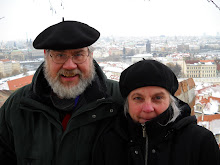Lindsay’s Blog February 9, 2010
Warsaw’s Catholic churches are apparently arranged around types of people so near us in Castle Square is a young adults’ church where many hold their weddings; we passed the military church where commemorations are held and the bishop (?) is powerful; we passed the artists and writers church – the homilies speak to these groups so attendance often breaks out along these lines.
So, who are the 11 young artists at the Magazyn Praga gallery – inward-looking, certainly not joyful but also not jaded or ironic. Surprisingly, all the work involved putting a brush or pen or pencil to paper, although some also incorporated photography and computer graphics. And I liked a few of them, getting a personal challenge or pleasure.
I ate horse meat for the first time last night! Not much, but it was carpaccio so scary but also not so much chance of a really weird texture.
Dave adds:
GREAT to get back to doing training – two days seemed a great yawning tunnel of time before we started. Then we get in the room – 25 wonderful people, wide ranging work, young and medium young, strong willed and open minded…A great translator, Magdalena had lived and studied in Montreal and works with NGO’s so she was aware and sensitive to the message as well as the words. Agnieshka and Karol from the Association super efficient and on-the-job in setting stuff up, copying pictures and evaluations, running around with newsprint sheets. The Association of Local Leaders has a close working relationship with OMB Watch and Public Citizen and Common Cause, and they are steadily approaching a role in supporting the growing network of folks in Poland who are doing – or want to do – organizing. Groups ranged widely. There was a tenants’ association (3 younger working class men and a big older guy, veteran of Solidarity and street protest, fighting to protect eviction victims and challenge the privatization of housing here. A rural town group focused on community involvement and good government, five leaders including an earnest young accountant and his bright young journalist wife, who publish a newspaper locally and are struggling with how to strengthen their base and widen their leadership. A young self described anarchist woman, trying to build an alliance within a labor union that centers on women’s rights. Great questions – how to manage conflict within the community, how to keep meetings lively, how to sort leader/organizer roles. Incredible spirit, good humor. And only two days!
After the training (and a good old fashioned 45 minute debrief!) we went on a brisk (9 below zero Celsius – what’s that in US dollars?) walking tour, guided by an attorney from the association who used to be a certified guide. I was hit hard by what we saw. 90% of this area (and 65% of all Warsaw) was flattened in the Second World War, the old parts rebuilt, and monuments all over to various massacres, revolts, uprisings and heroic resistance. In the old Jewish Ghetto, the guide said “we are walking on the ruins here…literally. The cellars were filled in and the bricks leveled and the surface was about 2 meters higher when these streets were built.” And the monument to the Ghetto Uprising, built from stone brought in (but never carved) by the Germans to build a monument to Hitler. And the mound with a blunt stone commemorating the spot where the last, cornered hundred fighters from the Jewish resistance committed suicide, imitating the Jews of Masada under Roman attack. “This building on the left (which I was touching as we passed) was SS headquarters. Across the street there, the rail station to Auschwitz.” The heroism, the evil, the horror, the sweep and re-sweep of history, the sheer awful ugly and beautiful drama of it. I walked and sniffed and reeled from the thoughts and emotions.
Tomorrow, off to Szczecin for Thursday/Friday workshops.
Subscribe to:
Post Comments (Atom)











Dave, your expeience walking across the ruins of the Ghetto reminded me of Bertolt Brecht's poem:
ReplyDeleteThe World's One Hope
Is oppression as old as the moss around ponds?
The moss around ponds is not avoidable.
Perhaps everyting I see is natural, and I am sick and want to remove
what cannot be removed?
I have read songs of the Egyptians, of their men who built the pyramids. They complained of their loads and asked when oppression would cease. That's four thousand years ago.
Oppression, it would seem, is like th moss and unavoidable.
When a child is about to be run down by a car one pulls it on to the pavement.
Not the kindly man does that, to whom they put up monuments.
Anyone pulls the child away from the car.
but here many have been run down, and many pass by and do nothing of the sort.
Is that because it's so many who are suffering? Should one not help them all the more because they are many? One helps them less. Even the kindly walk past and after that are as kindly as ever they were before waling past.
The more there are suffering, then, the more natural their sufferings appear. Who wants to prevent the fishes in the sea from getting wet?
And the suffering themselves share this callousness towards themselves and are lacking kindness towards themselves.
It is terrible that human beings so easily put up with existing conditions, not only with the sufferings of strangers but also with their own.
All those who have throught about the bad state of things refuse to appeal to the compassion of one group of people for another. But the compassion of the oppressed for the oppressed is indispensable.
It is the world's one hope.
Hi Dave and Lindsay!
ReplyDeleteBest greetings from TLUSZCZ :)
http://kastor.org.pl/2010/02/16/warsztaty-organizowania-spolecznosciowego-za-nami/
Ola